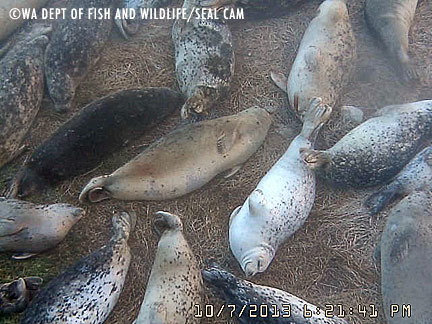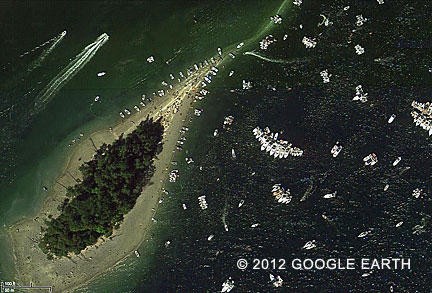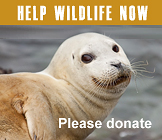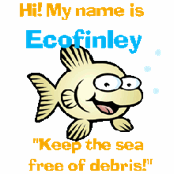haul out
Seal pupping season in full swing - stay away from seals and pups!
Jul/10/16 07:17 PM
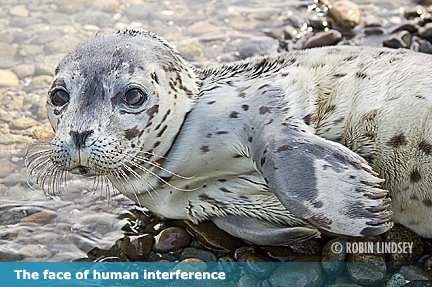
Nursing pups, however, are dependent on their moms for survival for the first 4-6 weeks of their lives. In the waters of Central and South Puget Sound, pups are born from late June through the first week of September (view a map of pupping season in WA). Always stay far back from any pup you come across.
A harbor seal mom, shy and wary of humans, will abandon her pup if people and dogs are around. Use common sense and help protect wildlife from harassment and abandonment.
YOUR PRESENCE CAN CAUSE STRESS AND ABANDONMENT
As you head for the beach, know that seashore revelry is definitely no party for harbor seal pups, who are seeking to rest onshore. Humans and dogs cause pups to be abandoned every year. A harbor seal mom often will not return for her nursing pup if there is a disturbance or perceived threat. It goes without saying that July fireworks cause animals to be abandoned every year.
If you find a spot for your picnic on a beach near a harbor seal, please move your picnic to another beach. There are reports of people with blankets and coolers surrounding a lone seal pup - finally calling the stranding network wondering why the mother did not return.
Weaned seal pups need space to rest undisturbed as well. A pup that is scared into the water wastes precious calories - and this can truly be the difference between life and death.
This is a reminder that when you venture out to the beach, whether by trail or boat, please respect animals’ space and need for quiet. Stay back!
SEALS ARE PROTECTED BY LAW FROM HARASSMENT
Please stay a minimum of 100 yards away from resting seals. Like all marine mammals, they are protected from harassment by the Marine Mammal Protection Act and Washington State law RCW 77.15.130 (a criminal misdemeanor, mandatory court appearance, punishable with up to 90 days in jail and up to $1000 fine).
STAY FAR AWAY FROM HARBOR SEAL HAUL-OUTS
Harbor seals gather in large groups this time of year at haul-outs (called rookeries during pupping season), where moms and pups find safety in numbers. Pups pay a terrible price for human disturbance. The seal pup shown above was found in 2012, starving on Cutts Island, along with two other emaciated pups and several dead ones. All had been abandoned by their mothers because boaters disrupted the seal colony on this small South Puget Sound island near Gig Harbor. Durning boating season, thousands of boats can be moored offshore at Cutts, disrupting this historic harbor seal haul-out.
A day of boating fun for people can be a death sentence for seal pups. When you are boating or kayaking, please stay far away from resting harbor seals.
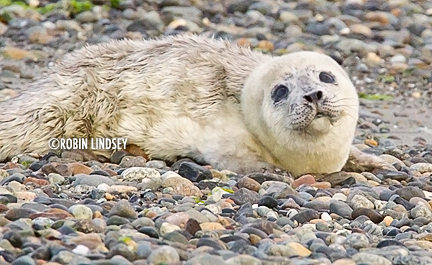
Please contact the stranding network to respond to a lanugo pup.
RESPECT NATURE AND STAY BACK
Leave seal pups be - don’t touch, move or feed them. If you are concerned about a pup, call the NOAA hotline @ 1-866-767-6114. To learn more about harbor seals and pups, visit Seal Sitters website here.
Seal pups on shore briefly today and others hanging around
Oct/11/13 09:47 PM
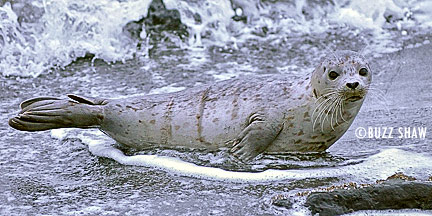
Later in the afternoon, 4 pups were observed foraging along the shoreline, but none that we know of came ashore. A pup was also sighted briefly on the protected beach at Jack Block Park. Perhaps the pups are resting at night or in locations that are less visible. The good news is, however, that we have pups still hanging around West Seattle and that they seem to be actively feeding. In the photo you can see Tiger’s long whiskers which detect vibrations from prey in the water. A recent study showed that the highly sensitive vibrissae contain thousands of nerves which enable a seal not only to locate prey, but determine size and species. This is why harbor seals are very effective hunters even at night or in deep, dark waters.
All of the harbor seal pups in South Puget Sound are now fully weaned. Almost all of the youngsters have left the relative safety of the rookeries to venture off on their own - and area haul-outs are full of grumpy adult seals, molting their coats and spending extended time on shore and less time feeding. While the molting process of harbor seals is not as grueling as the “catastrophic molt” of elephant seals, it is still a very trying time, particularly as winter months approach. Females who expended all of their resources to nurse pups for 4-6 weeks now face the additional physical stress of the molt. Thanks to WDFW-MMI for providing this seal cam photo of a freshly molted seal with a smooth new coat along with others who are still molting. Don’t forget to check out the WDFW seal cam webpage for a real-time look at a harbor seal haul-out and lots of informative articles and videos.
Haul-outs this time of year are not a welcoming place for new “weaners” to linger. All the more reason we need to offer them sanctuary on our urban beaches.
Respect harbor seal haulouts - it's life and death for seal pups
Aug/12/12 08:58 PM
Boaters, kayakers and jet skiers: Please be aware that locations where harbor seals gather are sensitive and vital areas - and disturbances to seal colonies can be devastating for newborn pups. Many Puget Sound islands have state parks with seal haul outs, where the animals gather in numbers to rest and, this time of year, give birth and nurse their young. Adult harbor seals are extremely skittish and the slightest disturbance can cause a stampede into the water, often leaving vulnerable pups alone on shore. If people land watercraft or swim or picnic close to a pup, the mom may well abandon him. On a state park island last year, WDFW Marine Mammal Investigations’ biologist found a group of picnickers surrounding a pup and was told they were “waiting for the mom to return.” It is no surprise that the mom never did.
This week, our lead responder accompanied that biologist on observations of South Puget Sound harbor seal rookeries. Responding to a report of a dead seal pup on that same small island with a known seal colony and a history of conflict with recreational boaters, we found two dead pups as well as three that were emaciated and weak, but alive - and several boats and a number of people way too close. We were told that just before we arrived a man tried to put one of the pups back into the water (one of many instances, we are sure). There is no chance a mom will return to take care of her pup under these circumstances. At right is a photo which shows the tiny island on a typical August day - a virtual flotilla of boats and people (click on the Google Earth photo to enlarge). There are reports of 100 boats at this island on a weekend.
This video shows seals fleeing from a nearby South Puget Sound rookery - as an eagle lands near them. You can imagine their terror when a boat lands on their beach.
Enforcing the Marine Mammal Protection Act in remote areas is challenging. Park rangers are few and far between and access to respond to islands is especially difficult. Signs that are posted are either torn down or graffitied beyond recognition. It appears that too many humans feel that their “right” to be in nature supersedes animals’ rights to survive in their daily life and death struggle. We are dependent upon the public to spread the word that no matter where you are, if you encounter a marine mammal on the beach, you are to stay 100 yards away. If someone is harassing a pup on the beach, call Seal Sitters’ hotline @ 206-905-7325 (SEAL) immediately and we will contact the proper authorities. Take a discreet photo of a boat showing license number - NOAA Office for Law Enforcement has a better chance of prosecution with physical evidence. Do not put yourself in harm’s way. If you find a pup that appears to be abandoned, keep your distance and call the hotline.
This week, our lead responder accompanied that biologist on observations of South Puget Sound harbor seal rookeries. Responding to a report of a dead seal pup on that same small island with a known seal colony and a history of conflict with recreational boaters, we found two dead pups as well as three that were emaciated and weak, but alive - and several boats and a number of people way too close. We were told that just before we arrived a man tried to put one of the pups back into the water (one of many instances, we are sure). There is no chance a mom will return to take care of her pup under these circumstances. At right is a photo which shows the tiny island on a typical August day - a virtual flotilla of boats and people (click on the Google Earth photo to enlarge). There are reports of 100 boats at this island on a weekend.
Enforcing the Marine Mammal Protection Act in remote areas is challenging. Park rangers are few and far between and access to respond to islands is especially difficult. Signs that are posted are either torn down or graffitied beyond recognition. It appears that too many humans feel that their “right” to be in nature supersedes animals’ rights to survive in their daily life and death struggle. We are dependent upon the public to spread the word that no matter where you are, if you encounter a marine mammal on the beach, you are to stay 100 yards away. If someone is harassing a pup on the beach, call Seal Sitters’ hotline @ 206-905-7325 (SEAL) immediately and we will contact the proper authorities. Take a discreet photo of a boat showing license number - NOAA Office for Law Enforcement has a better chance of prosecution with physical evidence. Do not put yourself in harm’s way. If you find a pup that appears to be abandoned, keep your distance and call the hotline.
Quiet day for Seal Sitters
Nov/13/10 03:18 PM
Ebb and flow determines haul out patterns of pups
Oct/24/10 05:24 AM
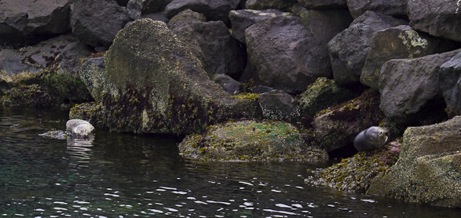
In the photo above, taken at late afternoon’s high tide, you can see Queen Latifah (on the right) who has just hauled out, along with another yet unidentified pup (on the left) who had been hauled out since the prior high tide at 7am. In the opposite photo, you can see the pup sleeping on the same rock at low tide - quite a disturbing sight to onlookers who worry that the pup is stranded.
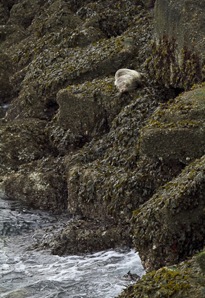
There are many factors which determine the haul out patterns of seals - and not all seals haul out at high tide. There are some haul outs that are only accessible at low tide. Other sites are accessible at all times and access is not affected by tidal influence. So, patterns appear to be site specific, but time of day, time of season, air temperature, wind and precipitation are all factors in addition to tidal heights. You can read one of many scientific papers on haul out patterns here.
UPDATE: The unidentified pup here came to be known as ET.
